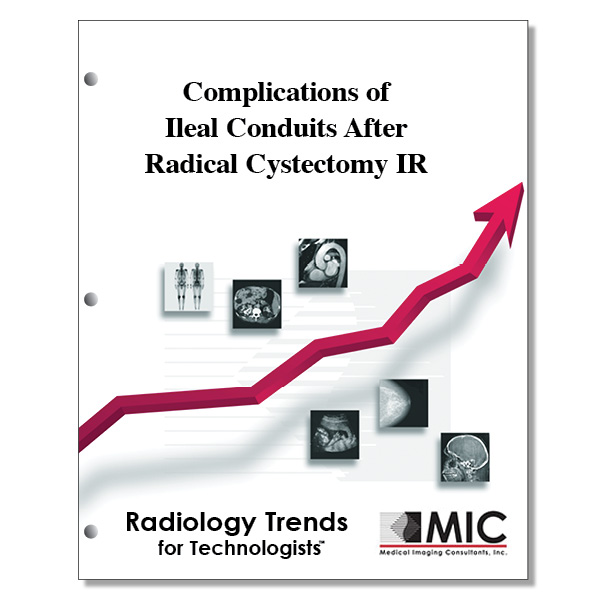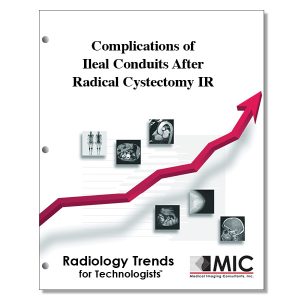

Complications of Ileal Conduits After Radical Cystectomy IR
Current approaches to interventional radiologic management of complications with ileal conduits are presented, and emphasis on ways to preserve the patients’ renal function and maintain their quality of life.
Course ID: Q00665 Category: Radiology Trends for Technologists Modalities: CT, Radiation Therapy, Radiography, Vascular Interventional3.0 |
Satisfaction Guarantee |
$34.00
- Targeted CE
- Outline
- Objectives
Targeted CE per ARRT’s Discipline, Category, and Subcategory classification:
[Note: Discipline-specific Targeted CE credits may be less than the total Category A credits approved for this course.]
Vascular-Interventional Radiography: 2.50
Procedures: 2.50
Nonvascular Procedures: 2.50
Outline
- Introduction
- Surgical Anatomy of an Ileal Conduit
- Ureteroileal Anastomosis
- Cutaneous Stoma
- General Considerations for Interventional Radiologic Management
- Early Complications
- Urine Leakage
- Ureteral Obstruction
- Postoperative Fluid Collection
- Fistulas
- Late Complications
- Ureteroileal Anastomotic Stricture
- Stoma-Related Complications
- Conduit Stenosis
- Urolithiasis
- Upper Urinary Tract Tumor Recurrence
- Ureteroarterial Fistula
- Stent-Related Complications
- Conclusion
Objectives
Upon completion of this course, students will:
- cite the major risk factor for bladder cancer
- state the percentage of bladder cancers that occur in males
- list the conditions that radical cystectomy with urinary diversion can help treat
- list the major techniques used for urinary diversion after radical cystectomy
- recall the year that ileal conduits were introduced into clinical practice
- list the patient and tumor factors affecting selection of urinary diversion
- list the patient types for which ileal conduit is generally used
- state the ileal conduit complications that require immediate surgical intervention
- list procedures often performed by interventional radiologists in diagnosis and management of complications related to ileal conduits
- state the first step of ileal conduit creation
- explain how the appropriate length of ileal segment is selected
- state the final step in creating an ileal conduit
- recall what part of the ileal segment is brought to the skin for stoma creation
- choose the techniques utilized for creating ureteroileal anastomosis
- choose the technique that combines the Wallace and Bricker techniques
- state the techniques currently used to create a cutaneous stoma
- explain which stoma technique is the most common
- compare and contrast stoma creation techniques
- discuss what can be done to prevent respiratory complications when performing a percutaneous nephrostomy on an elderly patient
- explain which calix is accessed for urine sample during percutaneous nephrostomy
- state the benefits of loopography as a diagnostic tool
- list early complications related to ileal conduits that can be managed with interventional radiologic techniques
- state the reported incidence of urine leakage after conduit urinary diversion
- explain why it is important to identify urine leaks associated with ileal conduit complications
- describe how patients with urine leakage may present
- explain how long nephroureteral stents should be left in place to permit ureteral healing
- recall the percentage of patients that may experience ureteral obstruction in the early postoperative period
- describe how patients with ureteral obstruction present
- choose the imaging modality that provides the study of choice in differentiating types of fluid collection in ileal conduit patients
- list the risk factors for developing a fistula post ileal conduit
- recall the overall complication rate related to ileal conduits 20 years after surgery
- list late complications of ileal conduit surgery that can be managed with interventional radiologic techniques
- explain how patients with ureteroileal anastomotic stricture may present
- choose the exam that is useful for assessing the patency of ureteroileal anastomosis
- explain what patients are best suited for long-term indwelling nephroureteral stent placement
- choose the most common late complication to occur after conduit diversion
- list complications associated with stomas following conduit diversion
- discuss the outcome of unaddressed stomal stenosis
- state the percent of urolithiasis in patients with an ileal conduit
- choose the best diagnostic study for depicting ureteroarterial fistula
